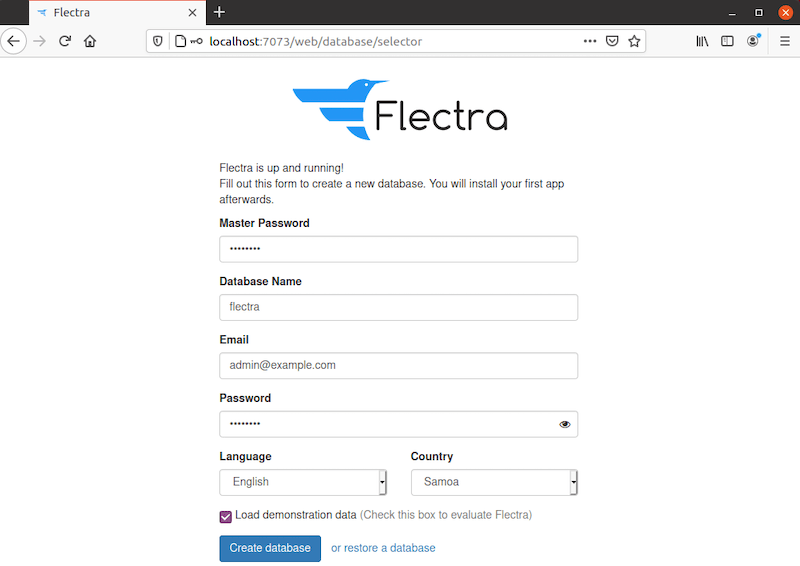
In this tutorial, we will show you how to install Flectra on CentOS 8. For those of you who didn’t know, Flectra is a free and open-source, CRM (customer relationship management) and ERP (enterprise resource planning) software system that provides a lot of flexibility and customization that lets you meet the unique needs of your business. In simple terms, Flectra gives you a comprehensive platform so that you can easily modify or configure it as per your requirements. Flectra provides a lot of features such as Accounting, E-Commerce, Inventory Management, Marketing, Project Management, CRM, Reporting, Leave Management, and many more.
This article assumes you have at least basic knowledge of Linux, know how to use the shell, and most importantly, you host your site on your own VPS. The installation is quite simple and assumes you are running in the root account, if not you may need to add ‘sudo‘ to the commands to get root privileges. I will show you through the step-by-step installation of the Flectra open source ERP and CRM software on CentOS 8.
Prerequisites
- A server running one of the following operating systems: CentOS 8.
- It’s recommended that you use a fresh OS install to prevent any potential issues.
- A
non-root sudo useror access to theroot user. We recommend acting as anon-root sudo user, however, as you can harm your system if you’re not careful when acting as the root.
Install Flectra on CentOS 8
Step 1. First, let’s start by ensuring your system is up-to-date.
sudo dnf clean all sudo dnf update
Step 2. Configure SELinux on the CentOS system.
We recommended disabling the SELinux in your system. You can disable it by editing the file /etc/selinux/config:
nano /etc/selinux/config
Change the following line:
SELINUX=disabled
Step 3. Installing Require Dependencies.
Now we install Flectra dependencies on your system. You can install all of them in one go by running the following command:
sudo dnf install python36 python36-devel git gcc wget nodejs libxslt-devel bzip2-devel openldap-devel libjpeg-devel freetype-devel
Next, run the following command to install the Node.js module:
npm install -g less
Also need to install the wkhtmltopdf package in your system:
wget https://github.com/wkhtmltopdf/packaging/releases/download/0.12.6-1/wkhtmltox-0.12.6-1.centos8.x86_64.rpm sudo dnf localinstall wkhtmltox-0.12.6-1.centos7.x86_64.rpm
Step 4. Installing PostgreSQL.
Now we install the PostgreSQL database using the following commands:
sudo dnf install postgresql-server
Once installing the PostgreSQL server, initialize the database with the following command:
postgresql-setup --initdb --unit postgresql
Next, start the PostgreSQL service and enable it to start at system reboot with the following command:
sudo systemctl start postgresql sudo systemctl enable postgresql
Step 5. Installing Install Flectra on CentOS 8.
First, create a separate user for Flectra. You can create it using the following command:
useradd -m -U -r -d /opt/flectra -s /bin/bash flectra
Once done, log in with the Flectra user and download Flectra from the Git repository:
su - flectra git clone --depth=1 --branch=1.0 https://gitlab.com/flectra-hq/flectra.git flectra
Then, create a virtual environment for Flectra:
python3 -m venv my-flectra
Next, activate the virtual environment using the following command:
source my-flectra/bin/activate
Afterward, install all Python modules by running the following command below:
pip3 install -r flectra/requirements.txt
When all required modules are installed, deactivate the virtual environment and exit by using the following command:
deactivate exit
Step 6. Configuring Flectra.
Now we create directories for Flectra configuration, executables, and log files:
mkdir /opt/flectra/flectra-custom-addons mkdir /var/log/flectra mkdir /etc/flectra touch /var/log/flectra/flectra.log
Change the owner of the newly created directories to Flectra user:
chown -R flectra:flectra /opt/flectra/flectra-custom-addons chown -R flectra:flectra /var/log/flectra/ chown -R flectra:flectra /etc/flectra
Next, we edit Flectra configuration file:
nano /etc/flectra/flectra.conf
Add the following lines:
[options] admin_passwd = your-strong-password-flectra db_host = False db_port = False db_user = flectra db_password = False logfile = /var/log/flectra/flectra.log logrotate = True proxy_mode = True addons_path = /opt/flectra/flectra/addons, /opt/flectra/flectra-custom-addons
Step 7. Create a Systemd Service for Flectra.
To enable autostart of Flectra at Linux startup, we need to create a systemd service for Flectra:
nano /etc/systemd/system/flectra.service
Add the following lines:
[Unit] Description=flectra #Requires=postgresql-10.6.service #After=network.target postgresql-10.6.service [Service] Type=simple SyslogIdentifier=flectra PermissionsStartOnly=true User=flectra Group=flectra ExecStart=/opt/flectra/my-flectra/bin/python3 /opt/flectra/flectra/flectra-bin -c /etc/flectra/flectra.conf StandardOutput=journal+console [Install] WantedBy=multi-user.target
Save and close, reload the systemd daemon and after reload start and enable the Flectra service:
sudo systemctl daemon-reload sudo systemctl start flectra sudo systemctl enable flectra
Step 8. Configure Nginx for Flectra.
First, install the Nginx web server using the following command:
sudo dnf install nginx
Once installed, start the Nginx service and enable it to start at system reboot:
sudo systemctl start nginx sudo systemctl enable nginx
Next, create a new Nginx virtual host configuration file for Flectra:
nano /etc/nginx/conf.d/flectra.conf
Add the following lines:
#flectra server
upstream flectra {
server 127.0.0.1:7073;
}
server {
listen 80;
server_name flectra.idroot.us;
proxy_read_timeout 720s;
proxy_connect_timeout 720s;
proxy_send_timeout 720s;
# Add Headers for flectra proxy mode
proxy_set_header X-Forwarded-Host $host;
proxy_set_header X-Forwarded-For $proxy_add_x_forwarded_for;
proxy_set_header X-Forwarded-Proto $scheme;
proxy_set_header X-Real-IP $remote_addr;
# log
access_log /var/log/nginx/flectra.access.log;
error_log /var/log/nginx/flectra.error.log;
# Redirect requests to flectra backend server
location / {
proxy_redirect off;
proxy_pass http://flectra;
}
# common gzip
gzip_types text/css text/less text/plain text/xml application/xml application/json application/javascript;
gzip on;
}
Save and close the file when you are finished. Then, restart the Nginx service to apply the changes:
sudo systemctl restart nginx
Step 9. Accessing the Flectra Web Interface.
To access the Flectra web interface, open your favorite web browser and search for the URL http://flectra.idroot.us, You will be greeted by the database configuration page:

Congratulations! You have successfully installed Flectra. Thanks for using this tutorial for installing the Flectra open source ERP and CRM software on CentOS 8 systems. For additional help or useful information, we recommend you check the official Flectra website.